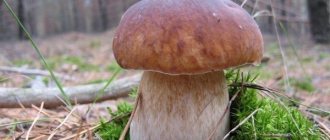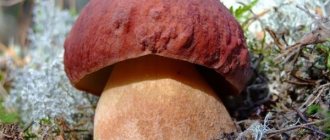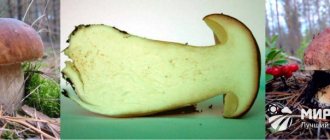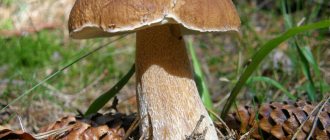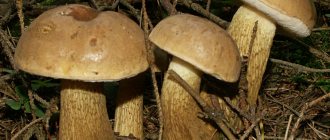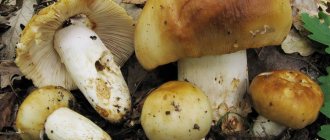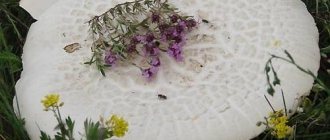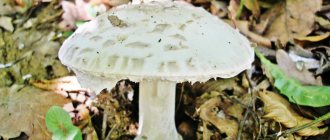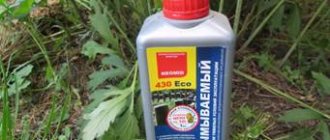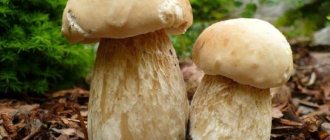The porcini mushroom, or boletus, is considered an elite tubular mushroom. When cut, it has snow-white flesh, which has a characteristic feature - it does not darken after heat treatment. It was this property that allowed it to be called white. Boletus is also famous for its taste: it has a rich mushroom taste and a delicate aroma with nutty notes.
The appearance of the mushroom does not correspond to its name: its cap is never white, and can have a shade from milky to brown. The younger the mushroom, the lighter its cap. The legs of these mushrooms have a mesh surface of milky, beige or gray color. They come in different sizes: from small to 7-10 cm in diameter to gigantic - more than 30 cm in diameter. It is believed that the largest white mushroom had a cap diameter of about 60 cm, and it weighed up to 11 kg. Such a find was reported by Moscow Radio in 1961.
White mushroom description
Porcini
has a delicate aroma and spicy taste. The cap of a mature mushroom grows on average 7-30 cm in diameter. But in some latitudes, with heavy rainfall, you can find a porcini mushroom with a cap diameter of 50 cm.
The color of the cap is from light brown to dark brown - it all depends on the trees under which the mushrooms grow
.
A young mushroom has a convex cap; as the mushroom ages, the cap becomes flat.
Where do porcini mushrooms grow?
The porcini mushroom grows on all continents, with the exception of cold Antarctica and arid Australia.
Most of all, the white mushroom is found in coniferous-deciduous forests with pine, oak, birch, spruce
. They prefer to grow under trees over 50 years old, they love lichens and places covered with moss.
Weather for mushroom growth
should be warm and rainy - June - August temperature 15-18 degrees, September - 8-10 degrees. Prefers warm, foggy nights - this is the time of harvest.
The porcini mushroom does not like waterlogged places - peat bogs and swamps.
Growth of porcini mushrooms
starts in
June
and continues until
September
, mass collection occurs in August. In the southern regions it can grow until October.
Mushrooms grow in columns-rings and families, so if you encounter only one mushroom in the forest, you will certainly find more.
Favorite places for mushrooms to grow
Mushroom pickers have favorite places for collecting boletus mushrooms, which are convenient in their location and rich in harvest.
One of these places is the Buzuluksky pine forest, located on the border of the Orenburg and Samara regions. It is located 15 km from the city of Buzuluk, after which it is named. The area of the forest is 1067.88 km2.
The main attraction of the area is the oldest pine trees, ranging from 300 to 350 years old.
Bor borders the steppe and is bordered by deciduous forest belt. A large variety of mushrooms grow here: boletus, honey mushrooms, saffron milk caps, boletus and russula.
While in these latitudes, you can also visit the villages of Mekhzavod, Upravlencheskiy and the villages of Shiryaevo, Borskoye and Malaya Malyshevka. They contain oyster mushrooms, morels, champignons and other mushrooms.
A good place for gathering is the Ulyanovsk forest park in the Novomoskovsk administrative district. It is located in a zone of spruce-deciduous forests without swamps. The predominant trees are birch, pine, oak and spruce. Their age ranges from 50 to 100 years.
The most common mushrooms in the forest park are: champignons, boletus mushrooms, boletus mushrooms and entolomas. If you're lucky, you might find a family of boletus.
An excellent solution would be to visit the Chelyabinsk city forest, located on the southwestern outskirts of the city. Borovaya territory occupies 1200 hectares. The forest is mainly filled with pine species with an admixture of warty and downy birch, aspen and alder.
There are also several productive areas near the city of Chelyabinsk: the areas of the villages of Shakhmatovo, Birgilda, Taktybai, the Ilmensky Nature Reserve and forests on the border with Bashkiria.
The boron region of these places is full of russula, boletus, boletus, boletus and boletus. Some areas of these territories are covered with entire families of these fungi.
Types of porcini mushrooms - photos and names
Depending on their habitat, porcini mushrooms come in different types.
White oak mushroom
— the cap is brown, not brown with a grayish tint. The pulp is loose, not as dense as that of birch forms. Found in oak forests from June to October.
White pine mushroom
- large cap with dark color. The pulp under the skin is brown in color. Can be found in pine forests. The mushroom stem is thick and short.
White birch mushroom
– the cap is light, almost white with a diameter of 5-15 cm. It grows exclusively under birch trees in birch forests and groves. Can be found from June to October alone and in groups.
Spruce porcini mushroom
– probably the most common type of porcini mushroom. The leg is elongated and has a thickening at the bottom. The hat is reddish-chestnut in color. Spruce mushroom can be found in spruce and fir forests.
False porcini mushroom (gall mushroom)
– the main difference from the porcini mushroom is that when cut, the flesh of the false mushroom darkens and becomes pinkish-brown. When cut, the porcini mushroom remains with white flesh.
The gall mushroom has a pronounced mesh on its stalk, which the edible white mushroom does not have.
The tubular layer of the gall fungus is pink; in a real porcini mushroom, this layer is white or yellowish.
A gall mushroom with bitter pulp that does not change even after boiling and frying, unlike the edible one.
Distribution and collection
This boletus forms mycorrhizae with oaks, chestnuts, lindens, beeches and hornbeams. Prefers deciduous forests. This species is widespread throughout almost all of Russia (including Karelia, Yakutia and Kamchatka), in the Scandinavian countries, and in Europe.
White mushroom reticulate shape.
The reticulated boletus is the earliest porcini mushroom. It appears at the end of spring and grows until October. During this time, several generations (“layers”) are replaced.
Beneficial properties of porcini mushrooms
Porcini mushrooms contain a large amount of minerals
– that’s why it is the most useful and popular mushroom.
The pulp of the porcini mushroom contains the optimal amount of selenium
, which can cure cancer at an early stage.
The pulp also contains calcium, iron and phytohormones.
.
Porcini mushroom contains riboflavin
, which helps normalize the thyroid gland, improves hair and nail growth.
Content of B vitamins
promotes energy metabolism, has a beneficial effect on the nervous system, brain function, and protects the skin from infections.
Lecithin
helps clean blood vessels from cholesterol.
E rgothioneine
helps in the renewal of body cells, is beneficial for the kidneys, liver, eyes, and bone marrow.
Low-calorie porcini mushroom
, well suited for drying, frying, stewing and pickling.
Any mushroom is difficult to digest, but dried porcini mushroom is the most accessible for digestion, and up to 80% of the protein is absorbed.
Edibility
This mushroom is considered one of the most delicious and edible boletus mushrooms. It can be used in food in various forms, and in any case it is wonderful.
Dried boletus has a unique aroma and is good in soups.
And also, these mushrooms lend themselves perfectly to pickling.
Mushrooms can be eaten fresh by lightly frying them in oil with potatoes.
White oak mushrooms have long been famous for their special healing properties. Thanks to this mushroom, you can make various decoctions and infusions that treat respiratory diseases. In Ancient Rus', ulcers and resulting tuberculosis were treated with the help of this mushroom.
The composition of the mushroom is rich in antioxidant vitamins. Also, the composition contains a substance such as carotene, which has a beneficial effect on the functioning of the heart and blood vessels.
Also, there is an opinion that boletus mushrooms have an antiseptic and anti-carcinogenic effect.
Some people consume them raw, using them in salads, however, we will not advise doing this, as it is quite risky.
Harm of porcini mushroom
This is an edible mushroom
, but they can be poisoned only in a few cases:
— porcini mushroom contains chitin and is poorly digestible by children, pregnant women, and people with diseases of the digestive system.
— like all mushrooms, the porcini mushroom also accumulates toxins contained in the soil. Do not pick mushrooms near businesses, within the city, near landfills, or highways.
- Some people have an allergic reaction to fungal spores.
— consumption of a dangerous double (poisonous gall mushroom) can lead to poisoning.
Valuable qualities
Porcini mushrooms are boiled, fried, pickled, frozen, dried, and in Italian cuisine they are even used raw to make salads. It goes great with potatoes.
Fresh boletus takes about 40 minutes to cook; dry boletus must first be soaked for several hours in cold water, and then cooked until completely settled. Ice cream is boiled for 30 minutes from the moment it boils.
Heat treatment leads to the destruction of all beneficial properties. Therefore, dried boletus mushrooms have special medicinal value, since they do not darken and acquire a mushroom aroma. They crunch just like this, without any additional processing.
Dried porcini mushrooms should be stored in paper bags, in a boiled room and at a fixed moderate temperature. Shelf life: 1 year.
Regular consumption of dried whites strengthens the immune system, is good for the eyes, hair, nails, helps prevent anemia, atherosclerosis, excellently stimulates digestion, and has a positive effect on the heart.
A teaspoon of white powder per day is considered good for preventing cancer.
Porcini mushrooms have natural antibiotics, which have proven themselves in the treatment of tuberculosis. Porridge from fresh boletus promotes rapid healing of wounds.
Boletuses are an important nutritious product; they are superior to meat in protein content.
Growing porcini mushrooms at home
Many people dream of growing porcini mushrooms in their garden plots, and this is a completely solvable task. All that is needed from you is time, perseverance and accuracy. The mushroom grows in the forest, so it cannot grow without symbiosis with a tree - keep this in mind.
The ideal option is when your plot of land is adjacent to a forest, although it can be grown with several trees growing on the plot. It can be oak, pine, birch, a couple of aspens, spruce. The trees must be at least 10 years old.
There are 2 main ways to grow porcini mushrooms:
- from mycelium
- from spores located in the mushroom cap.
Growing porcini mushrooms from mycelium
First you need to purchase quality material from a specialized store. Let's start preparing the site and planting. This can be done from May to September.
Around the tree you need to expose the soil, removing 15-20 cm of the top layer. You should end up with a circle with a diameter of 1-1.5 m. Save the top layer for later covering the area.
We place rotted compost or peat on the prepared area, the thickness of the fertile layer is no more than 2-3 cm.
We lay out pieces of prepared mycelium at a distance of 30-35 cm from each other and in a checkerboard pattern.
Finally, carefully cover the porcini mushroom mycelium with a layer of soil (which has been removed) and pour plenty of water - 2-3 buckets for each tree.
Mulch the watered area with a layer of straw 25-30 cm thick to maintain moisture.
Continue watering with fertilizers 1-2 times a week.
Before frost, cover the mycelium with a layer of foliage or forest moss. In spring, the shelter is carefully removed with a rake. The first harvest of porcini mushrooms will appear within a year, and with proper care, such a mycelium can bear fruit for 3-5 years.
Story with pictures, coloring pages and photos for 3rd grade
There are many stories and poems about Borovik. Fairy tales mention the kind spirit of an old man - Borovichka, who helps everyone. Having learned a simple poem, you can easily find Boletus in the forest based on the description.
On a hillock near the path, a mushroom stands on a thick stalk. A little damp from the rain, the porcini mushroom is large and important.
Early in the morning at dawn, in the morning fog, you need to go into the forest to pick mushrooms. No wonder the proverb says: “The first fog of summer is a sure sign of mushrooms.” Near the path, under a pine or oak tree, the Boletus mushroom grows. Since ancient times, Boletus mushrooms have also been called “colonels” because they tower above the rest of the mushrooms, as if they were in command. Much has been written about Boroviki in the stories of naturalists: Sigunov, Strizhev and others.
Growing porcini mushrooms from caps
For this method of breeding, you need to go into the forest and get some porcini mushrooms. Mature and even overripe mushrooms are better suited. Hats should have a diameter of at least 10-15 cm.
Also, when picking mushrooms, pay attention to what tree they grew under, so you will plant them under these in the future.
Separate the caps from the stems, you will need 7-12 caps per bucket of rainwater, soak for a day. Also add sugar 15 grams per 10 liters or alcohol 305 tbsp. l. for 10 liters.
After 24 hours, thoroughly knead the caps with your hands until smooth, filter through a layer of gauze.
Prepare the planting site as described in the previous propagation method. One difference is that you must first disinfect the peat or compost layer with a solution of tannins.
The solution recipe is to brew 100 grams of black tea in a liter of boiling water, or you can use oak bark by boiling 30 grams of bark for an hour.
When the solution has cooled, water the area at the rate of 3 liters per tree.
Next, pour the water with the spores evenly onto the fertile soil, while stirring the solution. Carefully place the remaining mushroom cake from the caps on top, cover everything with a layer of soil and a layer of straw.
Care for the mycelium as follows - abundant but not frequent watering. Insulate the area for the winter and remove the insulation layer in the spring.
There is nothing difficult about growing porcini mushrooms at home in your garden plot
.
Breeding boletus in the basement
In basements or garages, boxes filled with nutritious soil and installed on multi-tiered racks can be used for planting boletus mushrooms.
Experienced mushroom growers recommend adding buckwheat or sunflower husks, hay, deciduous or pine sawdust, and chopped corn cobs to the soil mixture.
The period of formation of the mycelium takes place in complete darkness, but with the appearance of the first small mushrooms you will have to take care of additional lighting.
It can be either natural or artificial: fluorescent lamps or more economical LED lamps are best suited. The total daylight hours should be 5 hours or more.

